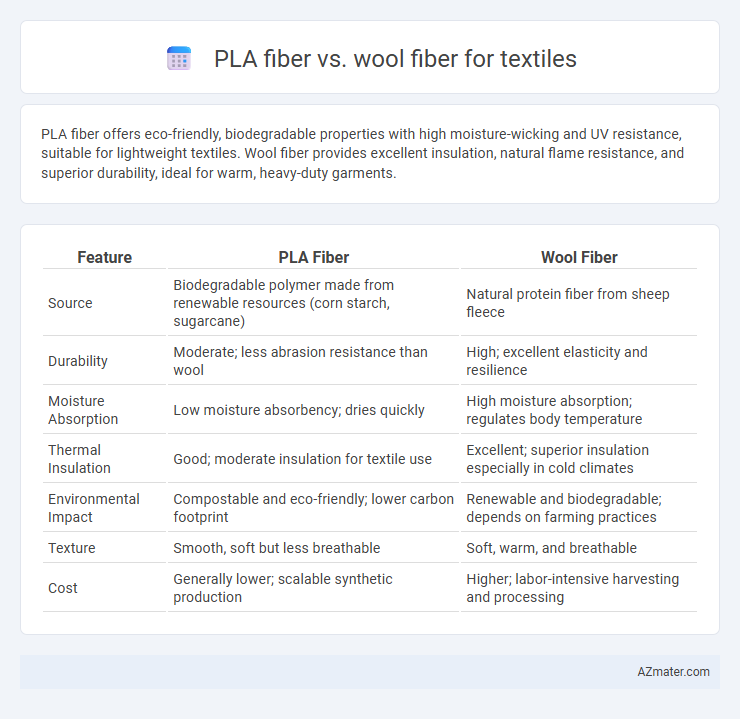PLA fiber offers eco-friendly, biodegradable properties with high moisture-wicking and UV resistance, suitable for lightweight textiles. Wool fiber provides excellent insulation, natural flame resistance, and superior durability, ideal for warm, heavy-duty garments.
Table of Comparison
| Feature | PLA Fiber | Wool Fiber |
|---|---|---|
| Source | Biodegradable polymer made from renewable resources (corn starch, sugarcane) | Natural protein fiber from sheep fleece |
| Durability | Moderate; less abrasion resistance than wool | High; excellent elasticity and resilience |
| Moisture Absorption | Low moisture absorbency; dries quickly | High moisture absorption; regulates body temperature |
| Thermal Insulation | Good; moderate insulation for textile use | Excellent; superior insulation especially in cold climates |
| Environmental Impact | Compostable and eco-friendly; lower carbon footprint | Renewable and biodegradable; depends on farming practices |
| Texture | Smooth, soft but less breathable | Soft, warm, and breathable |
| Cost | Generally lower; scalable synthetic production | Higher; labor-intensive harvesting and processing |
Introduction to PLA Fiber and Wool Fiber
PLA fiber, derived from renewable resources like corn starch, offers sustainable and biodegradable properties making it an eco-friendly alternative in textiles. Wool fiber, obtained from sheep, provides excellent insulation, moisture-wicking, and natural elasticity, widely valued for warmth and durability. Both fibers serve distinct niches, with PLA emphasizing environmental impact and wool focusing on performance and comfort in textile applications.
Origins and Production Processes
PLA fiber originates from renewable plant sources such as corn starch or sugarcane, and is produced through a fermentation process converting these carbohydrates into lactic acid, which is then polymerized into polylactic acid. Wool fiber is derived from the fleece of sheep, harvested through shearing, followed by cleaning, carding, and spinning to create yarns suitable for textile manufacturing. The production of PLA fiber emphasizes biotechnological fermentation and polymer extrusion, contrasting with wool's reliance on animal husbandry and mechanical processing techniques.
Biodegradability and Environmental Impact
PLA fiber, derived from renewable resources like corn starch, exhibits superior biodegradability under industrial composting conditions, breaking down into water, carbon dioxide, and biomass within 1-3 months. Wool fiber, sourced from animal fleece, is naturally biodegradable in soil and marine environments, decomposing over several months due to keratin proteins, while also providing soil nutrient enrichment. Environmental impact assessments show PLA reduces reliance on fossil fuels and lowers carbon emissions during production, whereas wool fiber promotes sustainable livestock farming but involves higher water and land use.
Physical Properties: Strength, Softness, and Elasticity
PLA fiber exhibits high tensile strength, making it durable and resistant to deformation compared to wool fiber, which has moderate strength but excels in softness due to its fine scales and natural crimp. Wool fiber offers superior elasticity, allowing it to stretch and recover without damage, whereas PLA fiber has lower elasticity and is more prone to permanent deformation under stress. The combination of PLA's strength and wool's softness and elasticity influences their respective applications in textile manufacturing, with PLA favored for durability and wool for comfort and flexibility.
Comfort and Wear Performance
PLA fiber offers superior moisture-wicking properties and breathability compared to wool fiber, enhancing comfort in warm and humid conditions. Wool fiber excels in thermal insulation and odor resistance, providing warmth and durability in cold climates while maintaining natural elasticity for wear performance. Both fibers demonstrate unique strengths, with PLA favoring lightweight, hypoallergenic textiles and wool delivering resilience and temperature regulation.
Moisture Management and Breathability
PLA fiber exhibits superior moisture management due to its hydrophobic nature, effectively wicking sweat away from the skin while maintaining quick-drying properties. Wool fiber naturally regulates moisture by absorbing up to 30% of its weight in water vapor without feeling wet, enhancing breathability and thermal insulation. Both fibers offer excellent breathability, but wool's unique lanolin content provides antimicrobial benefits, reducing odor in textile applications.
Dyeability and Color Retention
PLA fiber exhibits excellent dyeability with vibrant and uniform color absorption, making it suitable for a wide range of synthetic dyes. Wool fiber offers superior color retention due to its natural protein structure, which binds dyes strongly and resists fading over time. While PLA provides brighter colors initially, wool maintains color intensity and durability through extended use and washing.
Cost Comparison and Market Availability
PLA fiber offers a cost advantage over wool fiber due to its lower production expenses and scalability from renewable resources like corn starch, making it more affordable for mass-market textile applications. Wool fiber remains more expensive because of labor-intensive shearing, processing, and limited supply linked to livestock farming, which affects its market price and availability. Market availability favors PLA fiber in large-scale synthetic textile manufacturing, while wool maintains a niche presence, particularly in high-end, natural fiber garments.
Applications in Fashion and Textiles
PLA fiber, derived from renewable resources like corn starch, offers exceptional moisture-wicking and biodegradability, making it ideal for sustainable fashion applications such as athleisure and casual wear. Wool fiber, valued for its natural insulation, elasticity, and flame resistance, excels in high-quality outerwear, knitwear, and luxury textiles. Both fibers serve distinct roles in the fashion industry, with PLA driving eco-friendly innovation and wool providing timeless performance and comfort.
Future Prospects and Sustainability Challenges
PLA fiber, derived from renewable resources like corn starch, offers significant biodegradability and lower carbon emissions compared to wool, making it a promising sustainable alternative for the textile industry. Wool fiber, while naturally renewable and biodegradable, faces challenges related to methane emissions from sheep and land use intensity, which impact its overall environmental footprint. Future prospects for PLA focus on improving mechanical properties and recycling processes to enhance durability and reduce microplastic pollution, whereas wool's advancement depends on adopting regenerative grazing practices and advancing fiber processing technologies to minimize ecological impacts.

Infographic: PLA fiber vs Wool fiber for Textile
 azmater.com
azmater.com